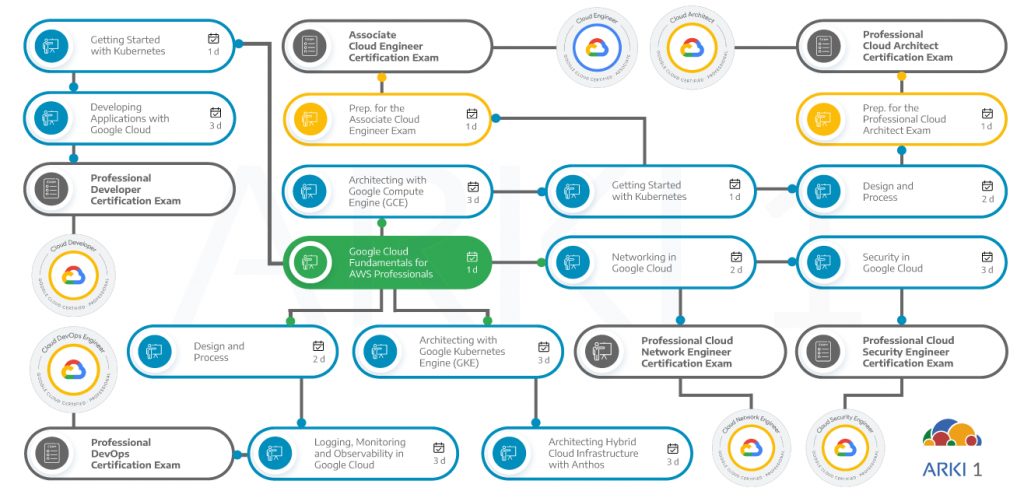This 1-day instructor led course introduces AWS professionals to the core capabilities of Google Cloud in the four technology pillars: networking, compute, storage, and database. It is designed for Azure system administrators, Solution Architects and SysOps Administrators familiar with AWS features and setup; and want to gain experience configuring Google Cloud products immediately. With presentations, demos, and hands-on labs, participants get details of similarities, differences, and initial how-tos quickly.
Objectives
In this course, participants will learn the following skills:
- Identify Google Cloud counterparts for AWS IaaS, AWS PaaS, AWS SQL, AWS Blob Storage, AWS Application Insights, and AWS Data Lake
- Configure accounts, billing, projects, networks, subnets, firewalls, VMs, disks, auto scaling, load balancing, storage, databases, IAM, and more
- Manage and monitor applications
- Explain feature and pricing model differences
Audience
This course is intended for the following participants:
- Individuals planning to deploy applications and create application environments on Google Cloud.
- Developers, systems operations professionals, and solution architects getting started with Google Cloud.
- Executives and business decision makers evaluating the potential of Google Cloud to address their business needs.
Prerrequisites
To get the most out of this course, participants should:
- Have basic proficiency with networking technologies like subnets and routing
- Have basic proficiency with command-line tools
- Students are expected to have experience with Amazon VPC, Amazon EC2 instances, and disks. Familiarity with Amazon S3 and AWS database technologies is recommended.
Duration
8 hours
Investment
Check the next open public class in our enrollment page.
If you are interested in a private training class for your company, contact us.
Course Outline
The course includes presentations, demonstrations, and hands-on labs.
- Explain the advantages of Google Cloud.
- Define the components of Google’s network infrastructure, including: Points of presence, data centers, regions, and zones.
- Understand the difference between Infrastructure-as-a-Service (IaaS) and Platform-as-a-Service (PaaS).
- Identify the purpose of projects on Google Cloud Platform.
- Understand how AWS’s resource hierarchy differs from Google Cloud’s.
- Understand the purpose of and use cases for Identity and Access Management.
- Understand how AWS IAM differs from Google Cloud IAM.
- List the methods of interacting with Google Cloud Platform.
- Launch a solution using Cloud Marketplace
- Identify the purpose and use cases for Google Compute Engine.
- Understand the basics of networking in Google Cloud Platform.
- Understand how Amazon VPC differs from Google VPC.
- Understand the similarities and differences between Amazon EC2 and Google Compute Engine.
- Understand how typical approaches to load-balancing in Google Cloud differ from those in AWS.
- Deploy applications using Google Compute Engine.
- Understand the purpose of and use cases for: Cloud Storage, Cloud SQL, Cloud Bigtable and Cloud Datastore.
- Understand how Amazon S3 and Amazon Glacier compare to Cloud Storage.
- Compare Google Cloud’s managed database services with Amazon RDS and Amazon Aurora.
- Learn how to choose among the various storage options on Google Cloud Platform.
- Load data from Cloud Storage into BigQuery.
- Perform a query on the data in BigQuery.
- Define the concept of a container and identify uses for containers.
- Identify the purpose of and use cases for Google Container Engine and Kubernetes.
- Understand how Amazon Elastic Container Service (ECS) and Amazon Elastic Kubernetes Service (EKS) differ from GKE.
- Provision a Kubernetes cluster using Kubernetes Engine.
- Deploy and manage Docker containers using kubectl.
- Understand the purpose of and use cases for Google App Engine.
- Contrast the App Engine Standard environment with the App Engine Flexible environment.
- Understand how App Engine differs from Amazon Elastic Beanstalk.
- Understand the purpose of and use cases for Google Cloud Endpoints.
- Understand options for software developers to host their source code.
- Understand the purpose of template-based creation and management of resources.
- Understand how Cloud Deployment Manager differs from AWS CloudFormation.
- Understand the purpose of integrated monitoring, alerting, and debugging.
- Understand how Google Monitoring differs from Amazon CloudWatch and AWS CloudTrail.
- Create a Deployment Manager deployment.
- Update a Deployment Manager deployment.
- View the load on a VM instance using Google Monitoring.
- Understand the purpose of and use cases for the products and services in the Google Cloud big data and machine learning platforms.
- Understand how Google Cloud BigQuery differs from AWS Data Lake.
- Understand how Google Cloud Pub/Sub differs from AWS Event Hubs and Service Bus.
- Understand how Google Cloud’s machine-learning APIs differ from AWS’s.
- Load data into BigQuery from Cloud Storage.
- Perform queries using BigQuery to gain insight into data.
- Review the products that make up Google Cloud and remember how to choose among them.
- Understand next steps for training and certification.
- Understand, at a high level, the process of migrating from AWS to Google Cloud.


